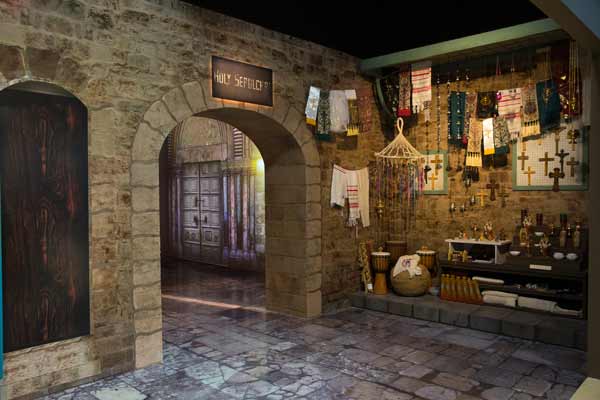
By Christopher White, The Tablet’s National Correspondent
WASHINGTON – Pilgrims hoping to visit one of the most sacred sights in Christendom earlier this week were prevented from entering the Church of the Holy Sepulchre in Jerusalem after a dispute with city officials attempting to levy a tax on church properties.
While the dispute ended after three days, those foiled from entering – or those with mere aspirations to experience the second best thing – can visit the National Geographic Museum for a 3-D visual tour.
“Tomb of Christ: the Church of the Holy Sepulchre Experience” runs through the end of 2018 and serves as an immersive tour of the history and the physical space of the ancient church built on the site where Christ is believed to have been crucified and buried.
Dating back to the fourth century, the church has been nearly destroyed and reconstructed on multiple occasions. In recent years, water leaks and smoke damage has led to much needed restoration, and in 2016, a major effort was made to restore the Holy Edicule, the site believed to be the exact tomb of Christ.
Fred Hiebert, who serves as National Geographic’s archaeologist-in-residence and curator of the exhibition, told The Tablet that this was “the first time in 200 years that the church agreed to carry out conservation of the most sacred site in all of Christianity.”
The restoration used sonar, laser scanning and thermal imaging to preserve the site and was chronicled by National Geographic. Marble stones and frescoes have been cleaned of soot and candle wax damage and for the first time ever, a window has been cut into the shrine for pilgrims to see the stone of the burial cave of Christ.
Opportunity Not to Be Missed
Hiebert said he was in Egypt – literally working in the tomb of King Tutankhamen – when he first heard about the project and considered it an “opportunity that could not have been missed,” so he packed his bags and headed to Israel to begin work on it.
He said that while National Geographic’s area of specialty “is the entire world,” the whole team was on board with documenting the conservation process in Jerusalem and making it as widely available for others to get a sense of that experience for themselves.
Today, the site is shared by six Christian Churches: The Greek Orthodox, Armenian Apostolic, Roman Catholic, Coptic, Ethiopian, and Syriac Orthodox churches, and nothing can take place within the confines of the Church unless there is unanimous consent.
“That didn’t make it easy to carry out the project,” Hiebert said, noting that the idea of conservation dates back to the 1950s, but the six groups could not agree on a plan until 2016.
Despite some internal bureaucracy, Hiebert said that the experience of seeing monks from different Churches get along so well-living and working closely together was an added benefit of the project.
‘Symbol of Optimism’
“I consider it a symbol of optimism that when push came to shove the Churches came together,” he said. “And I like to think that people will come to the museum and get that sense of optimism.”
Kathryn Keane, vice president of exhibitions for National Geographic, said that the she was impressed by how throughout the course of the year-long project, the church was only closed for a few hours. She said the Christian communities were adamant that there be no limit for pilgrims accessing the church during the conservation efforts.
Since the exhibit opened last November, she said it has become “a pilgrimage site in itself.”
“There are people who may never get to visit Jerusalem and being able to expose them to that special place is part of our goal, and for others who have been, it’s an opportunity for them to go back,” Keane explained.
“We hope that the exhibition will keep Jerusalem and all of our shared heritage and history in the spotlight and the Church itself,” she added.
For Hiebert, restoring one of the oldest sites in Christendom using the most current technology available, is proof that faith and science can be compatible.
“This project is an example of how faith and science can exist together,” said Hiebert, and “it’s a nice reminder that the great scientists of the past, the present, and hopefully the future are women and men of faith.”
“It’s nice to tell that story,” he concluded.
